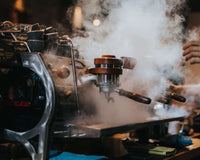Have you ever wondered, "How do I get my coffee to taste like the flavors notated on the packaging?" It's pretty simple: proper extraction. One of the best ways to get the most out of your coffee is to brew it by hand. Pour-over coffee is an intimate moment between you and your brewing tools that opens the door to better-tasting personalized coffee. Learning just the right touch to make each and every brew as fine-tuned as the next takes a bit of practice but once you have a proper road map to brew the perfect pour-over it ensures that you are setting yourself up for success. Plus it's just a fun ritual to partake in.
In this tutorial we feature the Fellow EKG Kettle, Acaia Pearl Scale, YAMA 6 Cup Pour Over Coffee Maker, Kalita 185 filters and OXO Conical Burr Grinder. It's important to note you can still achieve the same results with other products and at different price points. If you pay close attention to your grind, ratios and technique no coffee will be a match for your brewing skills.
HOW TO MAKE A PERFECT POUR OVER COFFEE
Step 1: Get Your Water Right
Start by heating up water in a goose or dragon neck kettle. A gooseneck allows you to have much more control over your pours which is essential to a perfect brew. We recommend heating up to 195-205 (ideally 202) degrees, any hotter or colder can result in inconsistencies

Step 2: Filter It
For this recipe we used a Kalita 185 Filter paired with our YAMA Stainless Steel Cone to achieve an ultra smooth brew. By no means is this a requirement. You can achieve amazing results with just a paper filter or stainless steel cone. Pour hot water over the filter saturating it to remove any paper taste the coffee may pick up. Additionally, warming everything up keeps the brewing temperature stable. After rinsing is complete discard water.

Step 3: Get Your Grind On
Grind your coffee to a medium grind setting. You can use any style reputable grinders to achieve this from hand grinders, conical grinders and higher end commercial grinders. The most important thing uniformity in your grind particles. It should have a little grit but not visibly chunky, resembling sea salt for example.

Step 4: Shake it
Add coffee to the brewer and give it a little shake to distribute the coffee evenly across. The goal should be to achieve a flat bed of coffee giving you a even surface to start your brew.

Step 5: All About Ratio
Zero out the scale and we are ready to brew! We recommend following the SCA Gold Cup Standard of 1:16 coffee to water ratio. For this recipe we used 20 grams of coffee which would result in 320 grams of water.
Tip: Don’t be afraid to experiment with the 1:16 ratio. We have found 1:15 can taste great as well as a 1:17, depending on the coffee, grinder and taste preferences.
Step 6: Here Comes the Bloom
Next comes our favorite part (besides drinking the coffee). This is where we start the “bloom” process. the idea is to saturate the grounds with roughly 60 grams of water allowing the co2 gasses to release resulting in majestic bubbly action. Wait about 30-45 seconds for the bloom to do her thing before resuming the brew process

Step 7: Focusing on the Technique
Gently add more water in continuous controlled circles. Start in the center while slowly spiraling outwards working your way to the outer edges, then slowly work your way back to the middle again. The idea is to create a stirring motion in your filter which will help with even extraction. The goal is to strive for a flat coffee bed when you are done brewing. Perform this method adding approximately 80 grams of water at a time, waiting for 30-45 seconds for it to steep, and continuing until you reach 320 grams (for 1:16 ratio at 20 grams of coffee).

Step 8: Brew Time
Let the coffee continue to drain into your mug or decanter. Your total brew time should be between 2-3 minutes. If not, you may need to adjust your pour or grind size to get to that desired time. If the brew time is under 2 minutes adjust your grinder to a finer setting as this will slow down the steeping. In turn, if the brew time is longer than 3 minutes then strive for a more coarse grind. Since everyone is using different equipment to brew their coffee there will likely be some adjusting to get things just right.
Step 9: ENJOY (and give back)
Discard the used grounds and filter. We encourage composting as it can add nitrogen to your compost piles, stays out of the landfill and plants love it. Coffee grounds are a source of fatty acids, essential oils and nutrients that can help enrich the soil, providing the nutrients and minerals required for healthy plant growth. Just make sure you keep the ratio around 10-20% coffee grounds to compost.
Pour coffee into your favorite mug and bask in it’s flavorful glory.







